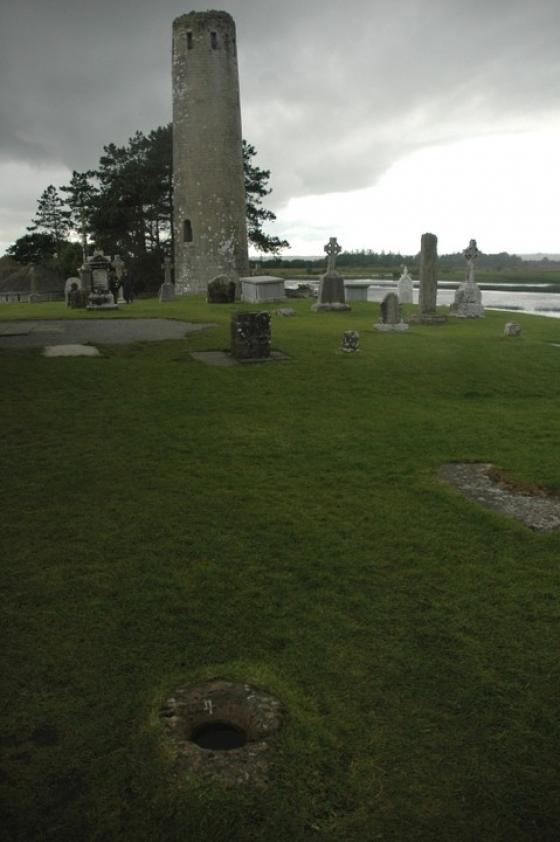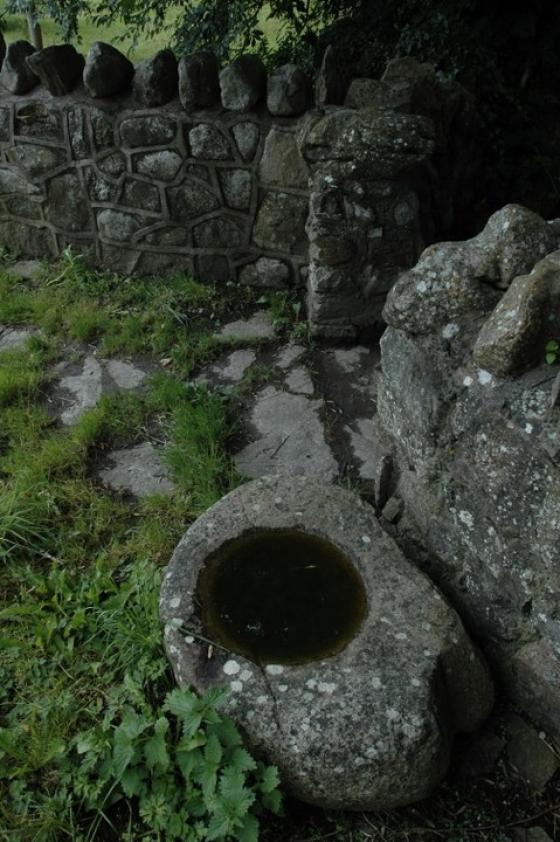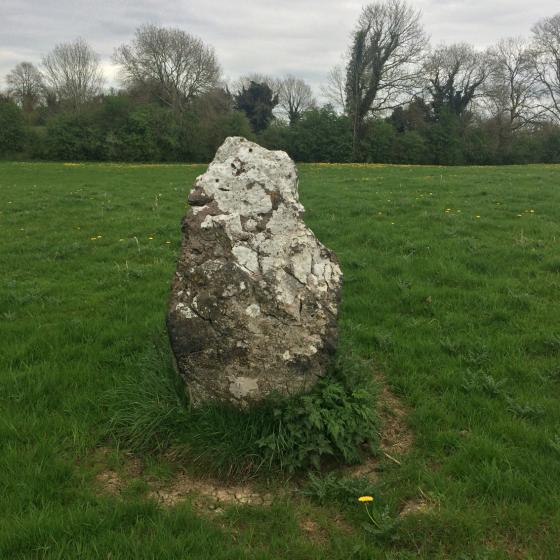
Human for scale

Human for scale

Close-up

29/3/15

The carvings are on the right hand side of the stone.

The only piece of rock art in Ireland with its own sign that I know of. (watch this space!)

Camera bag for scale. It’s a big beastie.

19/7/09

In its environment.


3 km east of Clonmacnois (near Clonfinlough Catholic Church) a large boulder lying flat on the ground in the middle of a field, decorated with a number of motifs including crosses, and something called “The split year” (acc. to H. Wirth, 1936) a circle divided in two halfs by a line. The rest of the ‘decorations’ are supposed to be natural, resulting from the effects of natural chemical solution. Similar signs were found on stones in Spain and were dated to the Bronze Age.
On both sides of the Shannon in this neighbourhood Christian tradition is busy with almost every stone, boher, and tougher, and close to this boulder, on the old boher which led to the Seven Churches of Clonmacnoise before the present road was formed, is a carn called Leacht-na-Marra, or the Monument of the Dead, where, to the present day, when a funeral approaches that famed burial ground, the coffin is laid down, and stones thrown on the carn. The tradition is that in the old times some of the “holy men” from the Seven Churches always attended here, and carried the corpse to its last resting place, about two miles distant, the laity not being allowed to enter the sacred precincts. The carn-raising, however, is the remnant of a Pagan tradition.
But I was distinctly informed that no Christian rite was ever performed at the Clonfinlough stone: on the contrary, the name by which it is known – “The Fairy’s Stone” – points to a Pagan origin. Two remarkable earthworks, no mean feats in their way, consisting each of a deep fosse and rampart drawn across the esker, not very far from this stone, are termed “The Witch’s Hollows.”
Another legend terms it “The Horseman’s Stone,” and tells that a horseman gallops round it at certain times. Mr T L Cooke, of Parsonstown – who is intimately acquainted with all the antiquities of the locality, and [..] some time ago kindly communicated to me a drawing of this stone [..]
He goes on to describe the boulder and its neighbours and their cup-like hollows and the carvings, comparing them to a sun with planets and the constellation of the Plough. He also mentions crosses, daggers, the resemblence of a human foot and representations of Irish ring-brooches etc. From ‘On a Boulder with Presumed Pagan Carvings at Clonfinlough, King’s County’ by James Graves. In The Journal of the Kilkenny and South-East of Ireland Archaeological Society,
New Series, Vol. 5, No. 2 (1865), pp. 354-362.
A page at the Offaly Historical and Archaeological Society summarises some of the local 1930s Folklore Commission reports:
This survey gives us a glimpse of how the people of Offaly treasured their monuments and how they perceived them and what social role they played in the minds of the local people. According to the folklore survey, the Clonfinlough stone had images in the form of cross-men and loop-men carved onto the surface of the rock. This image puzzled many antiquarians for years until one Abbe Breuil deciphered the image and concluded that it represented a fight to a finish between the Old Irish and the Milesians in pre-Christian times, 1300BC. The cross-men were charging at the loop-men who in return were retreating from the attack.
He told the locals that there were many such stones in Spain. The story went on to say that they believed it was the oldest stone in Ireland and described it as “A stone that before Our Lord founded his apostolic church lay there enjoying the glorious sunshine in Summer and the rain leaving it as pure and white as the lily, in winter”. Meanwhile, another story from the Clonmacnoise area records that there were two big rocks in a field which a local boy named Michael was continually playing around in the summer time. One summer day he was out playing as usual and he did not come in until dark. When he came in he began to tell his mother about a strange little boy he was playing with at the rocks.
He showed his mother a beautiful silver knife which he said he got from the little boy. When the mother saw the knife she was afraid to let him keep the knife and she made him go back to the rocks with her in order to return it. Michael left the knife on the rock and the next morning when he went out to play again, the knife was gone and he never saw the little boy again. It is said that the strange little boy was a fairy and he was trying to coax young Michael away. It is also said that another Michael will find the knife, and when he does he will find two big pots of gold under the rocks.
offalyhistory.com/articles/61/1/A-History-of-Offaly-Through-its-Monuments/Page1.html
Description and picture of the split year sign.












